Yekîneyên Parastina Gel T-72
The T-72 from Tamiya. In the ongoing Syrian civil war, the largely Kurdish west of the country is less of a conflict between the Free Syrian Army and Assad, and more of a conflict between the "Islamic State Of Iraq and the Levant" (ISIL / ISIS) and the "People's Protection Units" (Yekîneyên Parastina Gel / YPG) of the Kurdish Supreme Committee. With the fluid nature of war and the intricate, onion-like complexity of civil wars, it is difficult to accurately summarize the state of the conflict up to this point. However, the main position of the YPG is to prevent the greater Syrian conflict from spilling into Kurdish areas. The YPG is something of an anomaly in the Middle East, with a large number of women fighters and officers appointed by internal elections.
The YPG's armor force consists of vehicles captured from a variety of previous owners (ISIL, Assad loyalists, et cetera), and is a motley hodgepodge of whatever can be brought up to running order. The YPG has been recently crafting home-brewed armored vehicles by grafting armored shells on to civillian vehicles. Befitting vehicles that have had multiple owners, they're all looking a little worse for wear.
I had a T-55 and T-72 in the stash and decided to have some fun with them. Here is the T-72. I decided to use these kits as test mules for weathering techniques, so I didn't bother with any aftermarket. Here's what I did for the T-72. The hull and turret were assembled and given a full coat of Gunmetal Metalizer out of the rattle can. I prefer this for pre-shading over flat black because on styrene, it looks damned close to steel covered in mill scale.
I left off the side skirts at this point, because lots of photos of YPG machines show them in various states, but none of them had a full complement of side skirts. I started removing segments of the side skirts, attacking them with sandpaper and scalpel to give them a suitably battered look. I scraped off the small raised bits that represent the brackets that hold the skirts together and made two tiny pinholes where the bolts were. I started to mangle the right front fender as well. I then turned to the turret and drilled out some of the smoke launchers, after giving the turret cheeks some gentle re-shaping with a no. 11 blade to impart a more "steel casting" finish. The tires were suitably chipped and scuffed.
Once all of my modifications were complete and the side skirts attached, I sprayed the underside with Tamiya TS-2 Dark Green, then the sides with AS-6 Olive Drab, the topside of the hull with AS-14 Olive Green (USAF) and the turret AS-9 Dark Green. After this, I sprayed three rough lines of AS-11 Sea Grey over the whole topside of the tank, using a handheld piece of paper for an overspray guard. At this point I started playing around with weathering techniques; some hairspray was applied to the gun barrel, salt and liquid mask were applied to the hull. After everything was fully dried, I began misting TS-46 Light Sand and TS-3 Dark Yellow over the whole model, with an emphasis on the TS-3 to represent the ratty sand color most tanks in Syria seem to be sporting.
Once this coat was dry and the various media used as masks were removed, I started some touchup painting, like on the smoke grenade launcher caps, the rubber on the wheels that touches the treads and the searchlights. The tracks were sprayed with gunmetal and were slathered in a blend of various crushed and pulverized chalk pastels suspended in water. Once this was dry, I fitted the tracks to the model. The model then received some black watercolor washes on the engine deck and some highly thinned splashes of the aforementioned pastel slurry over the front. This was all sealed with a coat of testors dullcoat. I applied some burnt umber oil paint to places where I believe rust would have formed and then this too was sealed with another coat of dullcoat.
The YPG flag was printed on plain printer paper and affixed to the aerial with white glue.

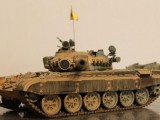
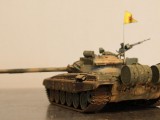

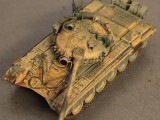
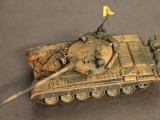
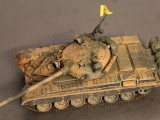
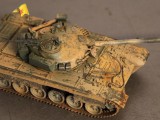
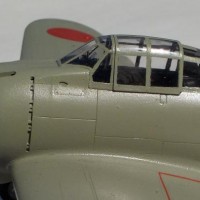
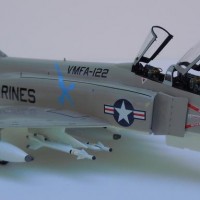
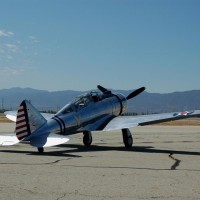
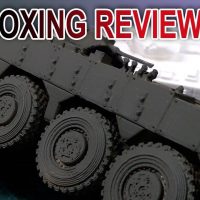
A brilliantly finished replica, sir...very nice indeed.
Unusual subject, great job, Wes. Looks just right !
Really outstanding work here.
Big "Like".
Good job on the weathering. Do you prefer the salt or hairspray technique?
I know the hairspray is supposed to be "easier," but for armor, I find the salt imparts a more realistic finish. At least when I do it, I find that some times the paint I spray on top of the salt gets drawn up by the salt and instead of it being smooth, there's a ridge around the place where the salt was. This is probably more of an after-effect of me spraying the paint on pretty heavy. Put the salt on thick and dry it before the under-coat is fully dry and you'll pull up some of that under-coat, which is pretty neat if you're trying to expose whatever is under the under-coat-- like the gunmetal!
This... ah... doesn't translate well to airframes. (don't ask)
(don't ask)
great looking tank, Wes.
Very nice armour, Wes, and the weathering techniques are well handled. A terrain base would be the icing on the cake.
Superb T-62 Wes beautifully weathered.
nicely done
Nice weathered build, great effect.
I enjoyed reading about the build and weathering, Wes, and it's interesting to see a modern armour model. I've learnt more about this conflict from your article that I would have done reading the news. Good job!
Wes,
Absolutely beautifully done.
That looks cracking mate. It could do with a wash though! Very realistic finish there on the weathering!